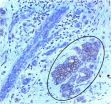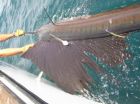Researchers find gene that protects against dementia in high-risk individuals
2010-12-23
(Press-News.org) JACKSONVILLE, Fla. — Neuroscientists had assumed that a mutation in the progranulin gene, which makes the progranulin protein and supports brain neurons, was sufficient to produce a kind of dementia known as frontotemporal lobar degeneration (FTLD). But now an international team of scientists led by researchers at Mayo Clinic's campus in Florida have found another genetic factor they say appears to protect against the disorder in progranulin mutation carriers.
In an article published in the Dec. 22, 2010, issue of Neurology, the medical journal of the American Academy of Neurology, the researchers report that people with a mutated progranulin gene who also inherited two copies of a specific variant of the TMEM106B gene are significantly less likely to develop FTLD or they have their disease onset delayed.
"This was an unexpected but very exciting finding because it suggests that if we could understand what TMEM106B is, and how it and its variants work, this could provide a new avenue for development of an agent that protects against FTLD," says the study's lead author, neuroscientist Rosa Rademakers, Ph.D.
The study was a follow-up to a genome-wide association study led by researchers from the University of Pennsylvania School of Medicine, which included 45 centers around the world and was published in March 2010 in Nature Genetics. This study used postmortem brain tissue to pinpoint variation in the TMEM106B gene as a risk factor for FTLD. What these patients all had in common was that they had lesions of misfolded TDP-43 proteins inside brain neurons. Researchers found that TMEM106B variants also played a role in FTLD patients with a progranulin mutation who invariably have these brain lesions.
"This research was designed to confirm the findings of the earlier study and to expand it to see if TMEM106B could modulate progranulin levels," Dr. Rademakers says. To do this, the researchers looked for the TMEM106B variant in a new set of patients, including 82 FTLD patients who had progranulin mutations, 562 FTLD patients without mutations, as well as a group of 822 healthy controls.
In the group as a whole, they did not see a significant association with TMEM106B, but there was a very significant association between TMEM106B variants and the development of FTLD in individuals with progranulin mutations.
The researchers found that individuals with a progranulin mutation who also inherited two copies of the protective TMEM106B allele did not develop FTLD or developed it at a much later age than is typical, which is normally around age 60, Dr. Rademakers says. "Since progranulin mutation carriers produce 50 percent less progranulin protein, we believe TMEM106B may affect progranulin levels and therefore specifically works in people with progranulin mutations," she says.
In support of their hypothesis, they found that individuals carrying the protective TMEM106B allele have more progranulin in their blood plasma, suggesting that the TMEM106B allele works to increase progranulin protein levels.
"The protective form of TMEM106B leads to higher levels of progranulin in the blood. Whether it also increases the levels of progranulin in the brain has not yet been studied and will be the focus of our future research," Dr. Rademakers says.
Not only could the beneficial TMEM106B allele be the basis of a novel therapy for individuals with a progranulin mutation, it might also help others who are at risk, for dementia she adds. "Subtle changes in progranulin levels have been linked to an increased risk for the development of FTLD, so now we have an interesting new lead to explore."
###
The study was funded by the National Institutes of Health and the Consortium for Frontotemporal Dementia Research. The authors declare no conflicts of interest.
About Mayo Clinic
Mayo Clinic is a nonprofit worldwide leader in medical care, research and education for people from all walks of life. For more information, visit www.mayoclinic.org/about/ and www.mayoclinic.org/news2010-jax/5837.html.
END
ELSE PRESS RELEASES FROM THIS DATE:
2010-12-23
JUPITER, FL, December 22, 2010 – A scientist from the Florida campus of The Scripps Research Institute has discovered a molecular switch that controls the synthesis of ribosomes. Ribosomes are the large machineries inside all living cells that produce proteins, the basic working units of any cell. These new findings offer a novel target for potential treatments for a range of diseases, including cancer.
The study is published in the December 24, 2010 edition of the Journal of Molecular Biology.
The study identified the molecular switch, essentially formed by a small ...
2010-12-23
AURORA, Colo. (Dec. 22, 2010)—A class of drugs thought to kill cancer cells may in fact block "cross talk" between the cancer cell and normal immune cells, resulting in reduced cancer growth and spread—a discovery that could significantly alter the way cancer drugs are evaluated in the future.
Researchers at the University of Colorado Cancer Center demonstrated the discovery in bladder cancer, the fifth most common cancer in the United States. Bladder cancer will kill about 14,000 Americans this year, most of whom will die as a result of the disease's spread to other ...
2010-12-23
University Park, Pa. -- A computer program that automatically analyzes mounds of satellite images and other data could help climate scientists keep track of complex, constantly changing environmental conditions, according to an international team of researchers.
"All of the data and information that is continually collected by satellites and sensors can cause tons of problems for scientists, who simply don't have the time to analyze every pixel of every satellite image," said James Wang, professor of information sciences and technology, Penn State. "Our goal has been ...
2010-12-23
WASHINGTON, D.C., December 22, 2010 -- What can scientists learn from watching a group of people sitting around, chatting, playing movies, reading, and happily making new friends? Quite a lot, says University of Melbourne, Australia acoustician Adam Vogel, who carefully observed this sort of group in a fatigue management study he and his colleagues describe this month in The Journal of the Acoustical Society of America.
Their report shows the effects of sustained wakefulness on speech and describes a novel method to acoustically analyze the effects of fatigue on the central ...
2010-12-23
Gaithersburg, MD – On December 14-15, 2010, the U.S. Food and Drug Administration (FDA) convened an Advisory Panel to discuss several scientific issues that may affect the regulation of dental amalgam. At the conclusion of the hearing, the Panel voted to recommend that the FDA conduct further review of the material's safety.
The meeting comes on the heels of a July 2009 Final Rule (http://bit.ly/FDA2009FinalRule) from the FDA that reclassified dental mercury from a class I device to a class II device and designated special controls for dental amalgam, mercury and amalgam ...
2010-12-23
PHILADELPHIA – Overexpression or hyperactivation of ErbB cell-surface receptors drives the growth of many breast cancers. Drugs, like Herceptin, that block the receptors' signals halt tumor progression in some patients. However, not all patients' tumors respond, with some becoming resistant over time. Different drugs that interfere with other steps in the signaling pathway may improve the response of patients, yet little is known about these molecules.
Now, Marcelo G. Kazanietz, PhD, professor of Pharmacology at the University of Pennsylvania School of Medicine and colleagues, ...
2010-12-23
Researchers at The Wistar Institute announce the release of an online tool that will help scientists find "gene promoters"—regions along a DNA strand that tell a cell's transcription machinery where to start reading in order to create a particular protein. The Mammalian Promoter Database (MPromDb) integrates the genome sequencing data generated at Wistar with publicly available data on human and mouse genomics. MPromDb pinpoints known promoters and predicts where new ones are likely to be found, the researchers say.
"Several complete genome sequences are available, including ...
2010-12-23
Researchers have discovered evidence of a distinct group of "archaic" humans existing outside of Africa more than 30,000 years ago at a time when Neanderthals are thought to have dominated Europe and Asia. But genetic testing shows that members of this new group were not Neanderthals, and they interbred with the ancestors of some modern humans who are alive today.
The journal Nature reported the finding this week. The National Science Foundation's Behavioral and Cognitive Sciences Division partially funded the research.
An international team of scientists led by Svante ...
2010-12-23
Billfish and tuna, important commercial and recreational fish species, may be more vulnerable to fishing pressure because of shrinking habitat, according to a new study published by scientists from NOAA, The Billfish Foundation, and University of Miami Rosenstiel School of Marine and Atmospheric Science.
An expanding zone of low oxygen, known as a hypoxic zone, in the Atlantic Ocean is encroaching upon these species' preferred oxygen-abundant habitat, forcing them into shallower waters where they are more likely to be caught.
During the study, published recently in ...
2010-12-23
MADISON – To survive in a tumultuous environment, sea urchins literally eat through stone, using their teeth to carve out nooks where the spiny creatures hide from predators and protect themselves from the crashing surf on the rocky shores and tide pools where they live.
The rock-boring behavior is astonishing, scientists agree, but what is truly remarkable is that, despite constant grinding and scraping on stone, urchin teeth never, ever get dull. The secret of their ever-sharp qualities has puzzled scientists for decades, but now a new report by scientists from the ...
LAST 30 PRESS RELEASES:
[Press-News.org] Researchers find gene that protects against dementia in high-risk individuals


